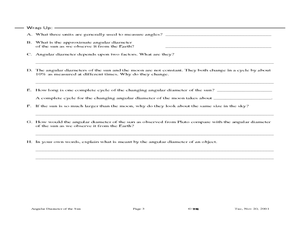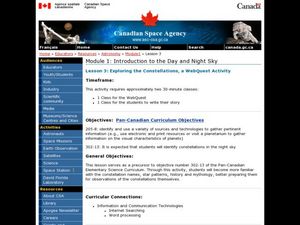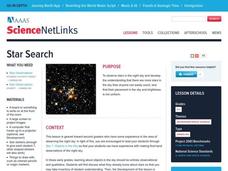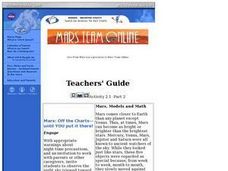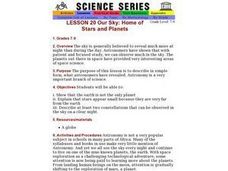NASA
Taking a Cold, Clear Look at the Universe
Take a look with another perspective. Pupils read to find out what portion of the electromagnetic spectrum a space telescope sees and the difficulties of viewing infrared radiation from other objects in space. Individuals discover how...
Curated OER
Planets Curriculum
Students investigate the planets in our solar system. They conduct research using a variety of resources in order for students to make cognitive connections with the demonstrations made by the teacher. Students discover how to recognize...
Curated OER
Planets Curriculum
Students complete an in-depth study of the known planets in the solar system. As a class, students identify the planets that are known in the universe, in the night sky. They explain the differences between planets and stars and the...
Curated OER
Water and Ice
Students explore water and ice. In this 3 states of matter lesson, students work with a partner to observe, illustrate, and describe the characteristics of an ice cube in a cup. The ice cube is observed again in 15 minutes and changes...
Curated OER
Photometry of Stars and Clusters
Students apply an algorithm to measure the distance to stars in the night sky. In this photometry lesson, students observe stars in the night sky as they measure the distance to them and to the cluster, The Milky Way. They apply the...
Curated OER
Mars Curriculum
Learners study Mars and other plants in the night sky. In a planetarium setting using Digitarium planetarium system, students identify the Big Dipper and Polaris. They explore the major differences between the planets and the stars. ...
Curated OER
Angular Diameter of the Sun
Starting with a paragraph of information presenting the different ways we can observe planetary objects, pupils work through these instructions to see how they can observe and measure angles. Your class will discover how these...
PBS
Star Power
Let there be light—or maybe not. Pupils learn about light pollution with an investigation of constellations. They create constellation boxes and experiment with different levels of light. Observations are then made about the lighting in...
American Museum of Natural History
Journey to the Stars
Fifteen detailed pictures and informative captions delve deep into the exploration of stars—their life cycle and importance in the universe.
Space Awareness
Star in a Box
What happens to stars as they get older? A simulation takes pupils through the life cycle of stars based on their masses. The resource introduces the Hertzsprung-Russell diagram and the common relationships and life cycle patterns observed.
Curated OER
Observing Mars in the Night Sky
Students compare and contrast the orbits of Earth and Mars, locate the planet Mars, and diagram its retrograde motion.
Curated OER
Observing and Sketching the Lunar Surface
Learners explore space science by conducting an illustration activity. In this lunar lesson plan, students discuss what the moon is and the role it plays for our environment on Earth. Learners view images of the moon and utilize chalk to...
Curated OER
Exploring the Constellations, a WebQuest Activity
Students explore space science by participating in a class WebQuest. In this constellation identification lesson, students view star charts based on the four seasons and identify the changes our sky goes through in the course of 12...
Curated OER
Multicultural Sun, Moon, and Star Activities
Students research the multicultural stories and artistic representations of the Sun, Moon, and stars. In this multicultural space lesson, students discuss the symbols and stories for the sun in various cultures. Students construct a...
Curated OER
Comparing Poems
Young literary analysts compare two poems by the same author. Readers look for slant rhyme, observe the beat and rhythm of each, and search for repeated vowel sounds. After re-reading, they observe the lack of punctuation and the stanza...
Curated OER
Too Bright at Night?
Students explore the consequences of light pollution. They consider benefits and drawbacks of technology in order to acquire informed attitudes on the various technologies and their social, cultural, economic, and ecological consequences. .
Curated OER
Plotting Sunspot Activity
Students explore how to graph sunspots using a solar graph. In this sunspots lesson students investigate sunspots and complete and evaluation worksheet.
Curated OER
Mars: Off the Charts--Until You Put It There
Students explore the night sky and make illustrations which are shared in class the next day. Distinctions are made between the stars and the planets and views of the constellations for the season are made available. The work of early...
Curated OER
Science: Day and Night
Students listen to the Sky Tellers Native American story, "Ant Dances for Light," and illustrate it. They observe how Earth's rotation results in periods of darkness and light. Students investigate how day length varies throughout the...
Curated OER
Our Sky: Home of Stars and Planets
Students discover that astronomy is a branch of science that includes the study of planets, stars, and constellations.
Curated OER
Geometry in the Constellations: The ER-2
Students discuss reasons to record the location of stars. They view a picture of the night sky, and discuss constellations. Students complete a worksheet of the various shapes they see in the constellations.
Curated OER
Mapping Constellations
Students become familiar with constellations. In this space science lesson, the teacher introduces constellations by showing students the star patterns and reading myths. Students, observe the stars nightly, then choose one constellation...
Curated OER
"Twinkle, Twinkle, Little Star"
Second graders sing the son "Twinkle, Twinkle, Little Star." They are asked:"How many of you have looked at the stars in the sky on a clear night? Have you ever wished on a star? What did you wish?" Students are explained the concept...








